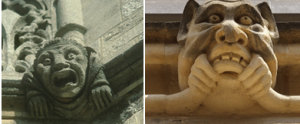 Although I found only one onomatopoeic word (iesca, a sob, hiccup, or belch), among early medical words in the Old English dictionary called the Epinal glossary, another, throtbolla (throat-boll, the Adam’s apple), of which more next time, was a translation of an onomatopoeic Latin word, gurgulio.
Although I found only one onomatopoeic word (iesca, a sob, hiccup, or belch), among early medical words in the Old English dictionary called the Epinal glossary, another, throtbolla (throat-boll, the Adam’s apple), of which more next time, was a translation of an onomatopoeic Latin word, gurgulio.
The Indo-European root GARG was an echoic representation of sounds made in the throat. The gorge is the throat, both externally and internally. “Thus,” wrote William Langland in Piers Ploughman, “they dribble at their dais the deity to know, And gnaw God in their gorge, when their guts are full.” To gorge is to fill one’s gorge and hence to stuff oneself.
To ingurgitate, now obsolete, was to swallow food or drink greedily; regurgitation meant paying the price. And early on regurgitation was also applied to the reflux of other bodily fluids, such as blood in the heart; you can hear it gurgling when you auscultate.
In Greek γαργᾰριζειν meant to gargle, and γαργᾰρεών meant the trachea or uvula, especially when inflamed, when it was also called σταφυλή, which meant a bunch of grapes. The English word “gargarize” gradually gave way to “gargle” in the 18th century.
Gargouille was the name of a dragon that lived in the river Seine and ravaged the city of Rouen, by whose archbishop, Romanus, it was slain in the 7th century. It gave its name to gargoyles, the grotesque sculptures through whose throats gutter waters could drain (picture). Grotesques are similar sculptures, but they function only as decorations, not as drains.

A gargoyle (left) and a grotesque (right) on the walls of the Bodleian Library in Oxford.
Consonantal shift, from l to r (lambdacism), and a little metathesis gives “glug”, the sound of liquids pouring down your throat or through the neck of a bottle.
Lose the r from GARG and you get “gag”. Lose the second g and you get an element that may have influenced the development of “gourmand” and “gourmet”, whose origins are otherwise unknown and which were probably influenced by other unrelated words, such as grumet, a wine merchant’s assistant.
In his grotesque five volume epic, Gargantua and Pantagruel, Alcofribas Nasier, better known as François Rabelais, used nicknames for many of his characters. When Gargamelle (“gullet”) gives birth, her husband Grangousier, who should know (his name means “large throat”), looks at the child and exclaims “Que grand tu as le gousier!” (“What a large throat you have!”). And “Que grand tu as” becomes “Gargantua”.
But names such as Gargan and Gargantua existed in mediaeval legends of giants long before Rabelais. Their origin is unclear, but garganta in both Spanish and Occitan means throat, so perhaps Rabelais wasn’t so far off, albeit fancifully. It is probably purely coincidental that in Greek γάργᾰρα meant heaps or lots. The name of Gargantua’s son, Pantagruel, comes from Greek and Arabic and means “all-thirsty”, or as we might say nowadays “necking everything”, although to neck, meaning to eat or drink greedily, dates back to the 16th century. In a 15th century work, Le mystère des actes des apôtres (The Acts of the Apostles), written by Simon and Arnoul Gréban for the Duke of Anjou, there is also a character called Pantagruel, an imp, whose business it is to throw salt into the throats of drunkards.
Part of Rabelais’s genius, particularly in his neologising, was to turn unoriginal material into something fresh. Mikhail Bakhtin, in his analysis of Rabelais, Творчество Франсуа Рабле (Tvorchestvo Fransua Rable, 1965; translated in 1984 by Hélène Iswolsky as Rabelais and his World), suggested that the throat names are ambiguous. A good appetite may be a sign of health, but gluttony is to be censured. Bakhtin metaphorically likened the gullet to the grave and the womb—it both swallows up (ingurgitates) and generates (regurgitates).
Rabelais’s story of the origin of Gargantua’s name is reminiscent of Kenneth Tynan’s 1969 show Oh! Calcutta! The title comes from the French surrealist Clovis Trouille (1889–1975), who was fond of depicting naked women. He called one of his paintings, a rear view, Oh! Calcutta! Calcutta!, echoing “O! quel cul t’as!”, which you’ll have to translate yourself.
Jeffrey Aronson is a clinical pharmacologist, working in the Centre for Evidence Based Medicine in Oxford’s Nuffield Department of Primary Care Health Sciences. He is also president emeritus of the British Pharmacological Society.
Competing interests: None declared.
